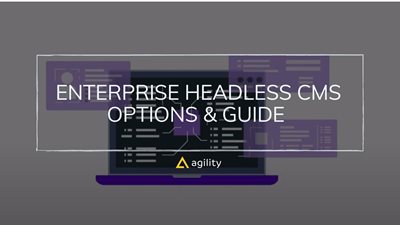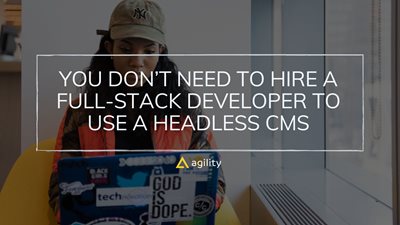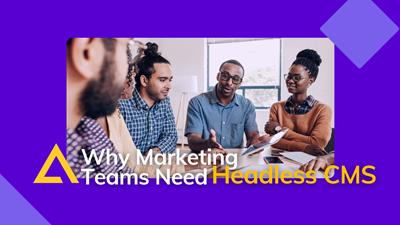Enterprise Headless CMS Vendors


Have you thought about expanding your digital company? Or do you intend to develop a company website, a mobile app, a digital display, a conversational interface, or mobile sites?
You'll need a CMS that can easily interact with your other systems and publish content across channels to handle these capabilities. However, for enterprise-grade digital experiences, the traditional content management system will be far from enough (CMS) (WordPress, Joomla, Drupal).
To supply an omnichannel user experience for your customers, you'll need the assistance of a Headless CMS. The term "headless CMS" has been floated around in digital content management for a while now. The abbreviation "CMS" stands for "content management system" and describes any software facilitating material administration. This article describes the headless enterprise cms platform, its benefits, and the types of businesses using it.
What exactly is a "headless" CMS platform?
An enterprise-grade CMS platform should be scalable and fast enough to manage heavy loads, and that's precisely what you get with a headless platform. The headless CMS is where everything, from content to assets, is kept. After that, you may utilize a content API to send the data to your site, app, newsletters, customer relationship management system, and anywhere else it may be helpful. With a robust design, you can meet consumer demands and compete in an increasingly oversaturated market.
Why do Companies need an Enterprise Headless Content Management System?
A headless content management system (CMS) is essential in today's omnichannel world.
While great for small start-ups, traditional systems (WordPress) severely hinder an organization's ability to scale. A traditional CMS requires individual content changes for each channel (mobile, kiosk, desktop).
A corporation shouldn't have to update 20 different systems if they change how they sell a product. Instead of uploading an image for each channel, with an enterprise Headless CMS, you can streamline your process, uploading and updating in seconds. Make the change in one place, and it will update everywhere else it needs to.
Headless CMS vs Enterprise Headless CMS
This comparison comes down to proprietary vs open-source.
The difference lies in the capabilities, extensibility, and support needed to build an enterprise-grade website.
Users
The first consideration between open-source and enterprise CMS is the user capacity. Systems like Strapi and Storyblok have free or very cheap packages to start with- but this is intended for small teams of 3-5 people.
Enterprise CMS companies may give the illusion of having a higher start-up cost, but in reality, they're designed only to take on enterprise clients, and that's the packages they offer. Strapi and Storyblok can be used for enterprise websites, but they cater to a larger niche.
An Enterprise CMS starts your Jamstack architecture with more users and more capabilities.
Traffic
If you're considering an enterprise CMS, your website likely generates decent traffic. If you launch a new ads campaign next month and skyrocket clicks, can your CMS of choice handle it?
In this sense, you get what you pay for.
The non-enterprise-focused Headless CMS vendors catering to a larger clientele have packages that can handle your traffic spikes. While this cost and capacity are on par with enterprise CMS, that's not their focus.
When a vendor has such a wide range of options and target audiences, they cannot meet the demands of enterprise clients. An enterprise CMS starts with an offering explicitly designed for enterprise sites and apps. Their entire system and offerings are intended and committed to enterprise clientele.
Security
If a Headless CMS vendor's target branches from free users to enterprise, they cannot meet the requirements of an enterprise CMS.
The security compliance between Agility CMS and a system like Storyblok is enough to differentiate between Headless CMS and Enterprise CMS.
Single Sign On (SSO) is a vital security measure in an enterprise CMS- like Agility CMS, which offers SSO for half the price of Storyblok's package, which is twice the price and has half the capabilities.
Non-enterprise systems will boast that they have ISO 27001- but that single certification is not enough to quantify as an enterprise CMS. An Enterprise CMS complies with SOC 2, ISO27001, ISO27018, Gold CSA Star, and more- which is what Agility CMS commits to its customers.
Agility CMS is also one of 2 vendors with Microsoft Azure Gold Certification (the other being Kentico).
Agility CMS uses Azure instead of AWS, like Storyblok. AWS' capabilities are more focused on open-source, while Azure ensures enterprise-grade systems are set up for success. Azure is the industry leader for security, recognized in the Forrester Wave Report, which is why over 95% of Fortune 500 companies use Azure.
Support
Fortune 500 and large enterprise companies need 24/7 support for you and your teams.
Those free or cheap packages with Storyblok come with 0 support because their objective is not to exclusively service enterprise clients.
Support with Storyblok is only offered once you bypass their main packages and enter the 'enterprise' level.
Agility CMS' packages are ALL built for enterprises. Support is offered for whichever pricing you opt into. Comparatively, you can start with Agility CMS at $1249 with support or pay $3000 to have support with Storyblok.
Enterprise CMS Options
Agility CMS
Agility CMS provides a powerful headless CMS. It dares to think differently by offering the industry's leading combination of website management and the flexibility of an API-first architecture. In a world where digital experiences shape business success, Agility CMS swiftly empowers you to gain a competitive edge through customer-centric digital experiences.
Designed for enterprise teams with intricate content requirements spanning multiple digital channels, Agility CMS is your solution for rapidly implementing a flexible DXP (Digital Experience Platform) model. With MACH-compliance at its core – embracing an API-first approach, cloud-based infrastructure, and genuine headless capabilities – Agility CMS seamlessly integrates into your Enterprise composable content architecture. Unleash your creative potential, for Agility CMS thrives on embracing unique challenges, enabling you to craft anything you envision.
Agility CMS goes beyond the ordinary Enterprise CMS landscape. While competitors might hold strong market shares, they often create obstacles for non-technical users. In contrast, Agility CMS is driven by the mission to empower editors, enabling marketers to seamlessly manage web content and allowing developers to focus on their coding expertise. The platform offers white glove service, ensuring that your journey with Agility CMS is as smooth as it is powerful.
Pros:
- Advanced multi-tenant features for efficient content management across diverse projects.
- Industry-leading security compliance, ensuring your content and data are safeguarded.
- User-friendly interface that caters to non-technical users, promoting autonomy and efficiency.
- Seamless scalability to accommodate growing content demands and evolving business needs.
- Robust scheduling and preview features for meticulous content planning and publishing.
- Enterprise-grade support, assisting when you need it the most.
- Collaboration features and customizable roles foster efficient teamwork.
- Distinguishing itself, Agility CMS is the sole Headless CMS offering the ability to manage pages through layouts, catering to your content structuring needs.
- Managing complex content becomes effortless with Agility CMS's flexible and intuitive tools.
Cons:
- While Agility CMS boasts numerous integrations, it may offer fewer out-of-the-box integrations than mainstream alternatives.
Experience the transformative capabilities of Agility CMS as it enables you to reshape digital experiences, drive innovation, and surpass expectations, all while delivering exceptional content management capabilities tailored for the enterprise environment.
Adobe Experience Manager
Adobe's Experience Manager is a suite of products and tools in one platform. The Experience Manager allows marketers to create personalized customer experiences across channels, build automation and campaigns, and process analytics.
Pros:
- Meets most requirements for enterprise websites
- Robust capabilities
- Multi-site environment
Cons:
- Requires a lot of setup and investment in building new sites
- Poor support
- Overwhelming for new users
- Lacks new iterations
- Padding issues
- User experience, especially for non-technical users
Contentstack
Contentstack is a part of the MACH alliance and provides a Headless CMS for enterprise clients.
Pros:
- Personalization features
- Friendly support team
- Collaboration features
- Easy integrations
Cons:
- User interface and UX is lacking
- Reliance on developers
- Steep learning curve
- Documentation
- Difficult to locate input fields
- Content search
- Bulk actions
Contentful
Contentful is the biggest Headless CMS vendor, offering a robust content hub.
Pros:
- Robust compared to traditional CMS
- Allows the creation of virtual meetings
- Personalization
- API Driven
- Customizable
- Speed
- Developer Experience
Cons:
- Configuration is difficult
- Reliance on developers
- API limitations
- Documentation
- Difficult to integrate apps
- Difficulty copying pages takes a long time
- Need to provide more training
- Need to improve the end-to-end experience
- Can't be integrated with all CRM platforms
- Poor communication with users about upcoming changes
Storyblok
Storyblok helps your company build digital stories with apps, websites, e-commerce and more.
Pros:
- Flexibility
- Visual editor
- Easy-to-use API
- GraphQL endpoints
- Transforms and resizes your images for websites and apps so that they are in an optimal form
- Speed and flexibility
- No coding knowledge is required
Cons:
- Rich-text editor
- Bugs
- Not as secure as other options
- Support costs more than other options
- User permissions and roles need more control
- Can't invalidate the image cache properly
- No stable support for Gatsby-image
- UI needs improvements
- The tool lacks flexibility and options for customizing your content
- Ecommerce integration requires a higher plan
- Relationships in the API are poorly implemented and difficult to workaround.
- The user interface and design sometimes feel cluttered.
Kontent.ai
Kontent.ai is a modular content platform that enables marketers and developers to deliver digital experiences.
Pros:
- Documentation
- API is easy to configure
- SDK support
- User-friendly
Cons:
- Lacks flexibility
- Issues configuring URL slugs
- Taxonomy translations
- Image uploads
- Reliance on developers
Sitecore Experience Platform
Sitecore offers content management combined with deep data insights.
Pros:
- Developer Community
- Out-of-box modules and features
- Multilingual and Multi-Language
Cons:
- Not a suitable solution for editors- full reliance on developers is expected
- Poor support
- Developer productivity
- Glitches that require an intimate HTML knowledge
- Lacking documentation
Benefits of an Enterprise, Headless Content Management System
The benefits of Headless CMS are used in different ways by each user. On the other hand, here are some of the more common ones:
Orchestrate content across platforms
Information can be distributed in several ways using a Headless Content Management System. Headless CMS is the answer to the problem of a growing number of devices and channels using the content.
Better, Quicker Content Editing
Managing and editing material requires time, energy, and resources for a user of a conventional CMS, while those who use a "headless" content management system won't have that problem. They are spared the trouble of handling the rendering process.
Increased Adaptability
Headless content management systems are more adaptable because APIs deliver content. Content is not a limiting factor; therefore, developers are free to experiment with new tools and frameworks. On the other hand, back-end content publication is possible without affecting the front-end.
Future-proof
A headless content management system (CMS) for businesses is fully interoperable with today's most cutting-edge tools. Additionally, compared to other CMS, it allows your company to perform better. Moreover, it looks like the tendency will only accelerate in the future.
Main Feature of an Enterprise Headless Cms
Many different headless CMS exist, yet they all share key similarities.
Authorizations and Functions of Individual Users
A good headless CMS will simplify managing your site's permissions and user roles.
Control of Images
Inserting, editing, and sharing images is a breeze in a headless CMS with a solid image-handling feature.
Rich APIs
An effective headless CMS will be able to communicate with your front-end structures. A robust application programming interface makes easy retrieval, modification, and data synchronization possible. GraphQL, a widely used technology, could serve as the foundation for the API. You may ask for precisely what you need using GraphQL, APIs can be updated more easily over time, and robust developer tools can be created.
Content Types
Use content types to model your id architecture. Content includes text lines, dropdowns, text areas, radio buttons, images, etc. The article, merchandise, and people are all examples of content types.
Correction Of Materials
You may view the history of your content's drafts and publishing, complete with the date and person responsible for each alteration.
Workflow
Put in place and specify workflows and approvals for content management and publication tailored to your team's work.
Best Methods for Selecting an Enterprise Headless Content Management System
Do a gap analysis
The likelihood is high that you already use a content management system. Seeing that your existing CMS is outdated may be evident, but the path forward may be less. First, evaluate your current content management system (CMS) and desired end state. Take a stab at answering these:
- Would you like to publish your material on more than one platform?
- Does the structure of your CMS allow you to implement your plans for the future of technology?
- Is the content management system (CMS) you're using the most recent release, or would you be better off upgrading?
- If your organization's capabilities fall short of its goals, it may be time to adopt a headless CMS.
Describe your needs and create a checklist
Your choice will also be influenced by factors other than your technological needs. Incompatibility with your team's established processes is a common cause of CMS deployment failure. Think about the developers' skill sets, work patterns, and the CMS's compatibility with their languages and frameworks. Try asking yourself:
- What is the compatibility between the CMS and the editors' and developers' workflows?
- Can a headless solution be developed if necessary?
- Is it easy to pick up, or will time and money be needed to get up to speed?
- Will it be simple for people to work together on documents?
Proof of Concept
After narrowing down your options and selecting a front-runner, conducting a proof of concept is the next logical step. Before beginning your test drive, communicate your needs and expectations to the seller so they can tailor the system to fit your specifications. It's essential to have a group of people with vested interests in the project's success, including programming, design, and content creation leaders. With this group in place, the headless CMS will function flawlessly for users, not only programmers. Put the solution through its paces by conducting real-world tests and creating an assessment sheet to track our progress.
Bottom Line
Everything we interact with nowadays is essentially content, and the internet is becoming a more integral to people's lives. Providing a more satisfying reading experience for our audience is crucial if we want to win their business. Businesses hope readers will take in all the content they produce, learn from the resources they offer, and ultimately buy something from them.
A headless content management system operates in this manner. It facilitates interaction with clients and improves services for end users. Headless CMS is the way forward for the CMS business, allowing for more mobility of content and consumer interaction across various devices, platforms, and channels.

About the Author
Harmonie is the Senior Marketing Manager at Agility CMS



